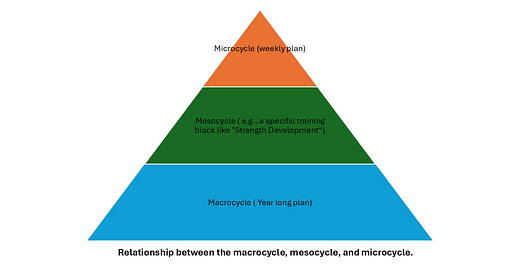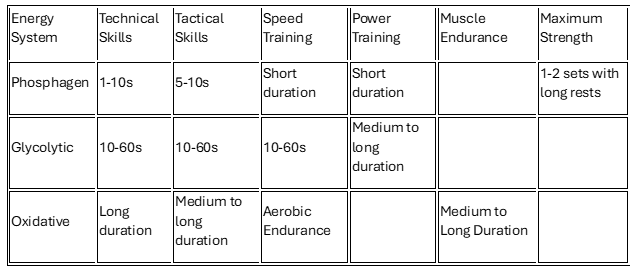The Swimmer's Blueprint: Deep Dive into Microcycle Planning for Peak Performance
As swimmers, we're constantly seeking the edge—that extra bit of speed, that more efficient stroke, the ability to push harder for longer. While raw talent and dedication are important, a structured, scientifically-backed training plan is the real key to unlocking your full potential. At the heart of such a plan lies the microcycle, a fundamental unit that dictates the daily and weekly rhythm of your training. This post will take you deep into the world of microcycle planning, explaining how to design, customize, and optimize these short training cycles to dramatically improve your swimming performance.
Understanding the Microcycle
• A microcycle, derived from the Greek "micros" (small) and the Latin "cyclus" (regular sequence), is a weekly or 3-7 day training program within an annual training plan. It is the most important functional planning tool in the training process.
• It's more than just a series of workouts; it's a carefully crafted sequence of training sessions with specific objectives, volume, intensity, and methods.
• The microcycle is not static; it must be flexible, adapting to the athlete’s working capacity, recovery needs, and competition plans
.It can be modified to address specific circumstances, but subsequent training should be adjusted to maintain focus
• The structure and content of the microcycle directly determine the quality of your training process
A Glimpse into the Past: Historical Perspective
The concept of structured training is not new. The ancient Greeks, such as Philostratus, understood the importance of planned training. His "tetra system," a 4-day training cycle, included a short, energetic program, intense exercise, recovery, and moderate exercise, illustrating early ideas about periodization. This highlights that the principles of organized training have historical roots, and we can still apply these methods.
Core Principles of Microcycle Construction
When building a microcycle for swimming, several criteria must be considered:
• Training Goal: Clearly define the objective of the microcycle, such as improving technique, building speed, or increasing endurance.
• Training Factors: Identify which specific biomotor abilities you are targeting, such as speed, strength, power, or endurance, and include technical and tactical training.
• Desired Improvements: Determine the specific performance improvements you are aiming for within that cycle.
• Sequencing: Carefully arrange training sessions to account for fatigue. A hard workout should not immediately precede a technically demanding one.
• Repetition: Repeated exposure to the training stimulus is key for improving technical elements and biomotor abilities. Vary the frequency of these stimuli throughout the week to maximize gains.
• Recovery: Schedule adequate recovery between sessions. The recovery period needed will depend on the training stimulus used. Incorporate active rest and relaxation, especially after high-demand sessions.
The Essential Elements of a Swimming Microcycle
A well-designed swimming microcycle will incorporate the following key components:
• Technical or Tactical Training: Focus on stroke mechanics, starts, turns, and race strategies.
• Speed, Agility, or Power Development: Include sprint sets, resistance drills, and explosive exercises.
• Strength Training: Incorporate dryland exercises targeting swimming-specific muscle groups.
• Specific Endurance Development: Training should vary from submaximal intensity three times per week to maximal intensity twice per week during the competitive phase. Low-intensity training should also be included.
• Flexibility Training: Include stretching and mobility exercises to prevent injury.
Classifying Microcycles: A Variety of Structures
Microcycles can be classified in several ways, including by training objectives and number of sessions per week:
• Developmental Microcycles: Focus on improving adaptation, skills, and biomotor abilities in the preparatory phase. These typically include 2-3 peaks of medium and high demand.
• Shock Microcycles: Feature a sudden increase in training demand to facilitate performance gains, typically with 2-4 peaks in the middle to second part of the preparatory phase.
• Recovery–Regeneration Microcycles: Designed to dissipate fatigue and enhance preparedness with low training demand.
• Peaking and Unloading Microcycles: Used to reduce fatigue and maximize performance before a competition.
• Microcycles Based on Training Sessions Per Week: Microcycles can be structured around the number of training sessions per week, such as three, four, five, or even eight sessions. More advanced athletes with a high work tolerance can use microcycles with more training sessions
• Microcycles Based on Daily Structure: Microcycles can have a 3+1 structure (3 training sessions and 1/2 day of rest): Suitable for beginner or intermediate swimmers.
· 4 days per week: Good for intermediate swimmers looking to increase training load.
· For more advanced swimmers with higher training tolerance.
· 5+1 structure (five training sessions plus 1/2 day of rest), or a 5+1+1 structure (five sessions, 1/2 day rest and 1/2 day of work): For more advanced swimmers with higher training tolerance.
· 8 sessions: Intensive for highly trained swimmers with ample time.
Customizing Your Swimming Microcycle
Here’s how to tailor microcycles for swimming:
· Frequency: Choose a 3, 4, or 5-day training structure based on your training level and time availability.
· Multiple Sessions: Combine multiple training focuses into a single day. For example, a sprint/agility session in the morning and a technique/strength session in the afternoon.
· Intensity Variation: Alternate between intensity zones throughout the week. As shown in Table 8.1, these zones range from very high (90-100% of max) to recovery (no training).
· Competition Timing: The highest intensity session should occur 3-5 days before a competition.
Sample Microcycle Structure for Swimming
The following is a possible microcycle structure for a competitive swimmer, focusing on integrating multiple training factors
Intensity and Training Demand
Training intensity should vary throughout the microcycle, ranging from very high (90-100% of maximum) to recovery sessions. The intensity zones and their training demands are outlined in the below table:
Competition-Specific Microcycles
• Weekly Competition: Include 1-2 recovery days, followed by training, and then 1-2 unloading days before a competition.
• Multiple Competitions: Incorporate regeneration sessions and high-demand training days to prepare for multiple races or meets.
• Multi-Day Tournaments: Include active recovery sessions between races, ensure proper carb intake, and plan for a low-intensity tactical session before each race.
Modeling Competition
• To prepare for major events, create a microcycle that mirrors the competitive schedule, including the timing of preliminary rounds and finals.
• Repeat this competitive model every 2-3 weeks, alternating with developmental microcycles.
Recovery and Regeneration: The Key to Adaptation
• Recovery is essential for performance gains. Regeneration microcycles help dissipate fatigue, elevate preparedness, and improve performance.
• Integrate rest days, intensity variations, and alternative training methods to facilitate recovery.
• Restoration sessions can include longer warm-ups, light work, and recovery activities like stretching and massage.
· Regeneration techniques such as warm water immersion, massage, sauna, contrast therapy and cold water immersion
Techniques
◦ Warm water immersion (10-20 minutes at 37-45 °C)
◦ Total body massage (10-20 minutes)
◦ Sauna (30 minutes at 60-140 °C, 5-15% humidity)
◦ Contrast therapy (20 minutes alternating between 37-44 °C and 7-20 °C)
◦ Cold water immersion (20 minutes at 12-18 °C)
Quantifying Training: Measuring Your Progress
• Use objective methods to quantify training intensity and volume.
• Volume: Measure total distance, repetitions, or time.
• Intensity: Use percentages of max speed, heart rate, or time for specific sets.
• Subjective Methods: Use perceived exertion ratings if objective measures are hard to obtain.
• Intensity Zones: Identify 3-5 training intensities based on sport demands, such as speed, stroke rate, and heart rate.
Alternating Intensity and Energy Systems
• Vary training intensities to avoid exhaustion and overtraining.
• Higher intensities target the anaerobic system, while lower intensities emphasize the aerobic system.
• Alternate the energy systems targeted in training to manage fatigue and stimulate adaptation.
• All energy systems are active at the same time and the intensity of the activity will determine which energy system is emphasized.
• Classify skills and training by the energy systems they primarily target.
Classification of Skills and Physical Training for Alternating Energy Systems
The Macrocycle: A Broader Perspective
• A macrocycle is a training phase lasting 2 to 7 weeks, comprised of several microcycles. It is used to plan training several weeks in advance and is the general structure of the training.
• Macrocycle length depends on the training phase; preparatory phases typically have longer macrocycles, while competition phases have shorter ones.
Types of Macrocycles
• Accumulation: To elevate the athlete’s potential by improving conditioning and technical ability.
• Transmutation: To use the base developed in the accumulation phase and work on preparedness.
• Realization: To improve competitive performance
During the preparatory phase, macrocycles are longer (4-7 weeks) with step-loading methods like the 4:1 or 3:1 loading patterns. Shock macrocycles can also be used, followed by regeneration macrocycles. Competitive phase macrocycles are shorter, dictated by the competition schedule.
Conclusion
Effective microcycle planning is crucial for optimal swimming performance. By thoughtfully applying the principles of periodization, varying training stimuli, and prioritizing recovery, you can create a training plan that delivers consistent improvement and peak performance when it matters most. Remember that individualized plans and modifications are necessary for every swimmer to best reach their potential.








